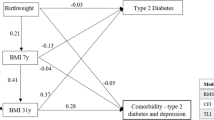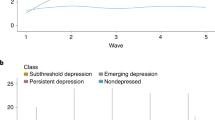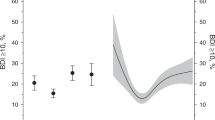Abstract
Objective:
Longitudinal studies have rarely investigated changes in depressive symptoms and indicators of obesity simultaneously, although it is often proposed that the positive relationship between depression and obesity is bidirectional. The present study examined the reciprocal nature of the relationship between depressive symptoms and body mass index (BMI) in a 20-year follow-up survey.
Methods:
Participants of a Finnish cohort study in 1989 at 22 years (N=1656) were followed up at ages 32 (N=1262) and 42 (N=1155) with postal questionnaires. BMI was calculated on the basis of self-reported weight and height, and depressive symptoms were assessed using the short form of the Beck Depression Inventory. Latent growth models (LGM) and cross-lagged autoregressive models were used to determine prospective associations between depressive symptoms and BMI.
Results:
LGM analyses indicated that men with higher initial levels of depressive symptoms experienced a faster rate of increase in BMI (β=0.20, P<0.01). Among women, change in BMI or depressive symptoms was not predicted by the other construct, but initial levels of BMI and depressive symptoms as well as their rate of change correlated positively with each other (r=0.15 and 0.37, respectively). In cross-lagged models, depressive symptoms at age 32 predicted greater BMI at 42 (β=0.10, P<0.001) among men, whereas women with higher BMI at age 32 were more likely to have more depressive symptoms at 42 (β=0.08, P<0.05).
Conclusions:
Elevated depressive symptoms predicted weight gain in men, while changes in depressive symptoms and body weight occurred concurrently in women. Tentative evidence showed that women with excess body weight were more likely to have increased symptoms of depression 10 years later. More emphasis should be placed on depressive symptoms in weight control programs as well as on reducing weight-based stigmatization and discrimination in society.
This is a preview of subscription content, access via your institution
Access options
Subscribe to this journal
Receive 12 print issues and online access
$259.00 per year
only $21.58 per issue
Buy this article
- Purchase on Springer Link
- Instant access to full article PDF
Prices may be subject to local taxes which are calculated during checkout



Similar content being viewed by others
References
Lopez AD, Mathers CD, Ezzati M, Jamison DT, Murray CJL (eds). Global Burden of Disease and Risk Factors. The International Bank for Reconstruction and Development/The World Bank: Washington, DC, USA, 2006.
Atlantis E, Baker M . Obesity effects on depression: systematic review of epidemiological studies. Int J Obes (Lond) 2008; 32: 881–891.
Blaine B . Does depression cause obesity?: A meta-analysis of longitudinal studies of depression and weight control. J Health Psychol 2008; 13: 1190–1197.
Rooke SE, Thorsteinsson EB . Examining the temporal relationship between depression and obesity: meta-analyses of prospective research. Health Psychol Rev 2008; 2: 94–109.
Luppino FS, de Wit LM, Bouvy PF, Stijnen T, Cuijpers P, Penninx BW et al. Overweight, obesity, and depression: a systematic review and meta-analysis of longitudinal studies. Arch Gen Psychiatry 2010; 67: 220–229.
Faith MS, Butryn M, Wadden TA, Fabricatore A, Nguyen AM, Heymsfield SB . Evidence for prospective associations among depression and obesity in population-based studies. Obes Rev 2011; 12: e438–e453.
Pan A, Sun Q, Czernichow S, Kivimaki M, Okereke OI, Lucas M et al. Bidirectional association between depression and obesity in middle-aged and older women. Int J Obes (Lond) 2012; 36: 595–602.
Needham BL, Epel ES, Adler NE, Kiefe C . Trajectories of change in obesity and symptoms of depression: the CARDIA study. Am J Public Health 2010; 100: 1040–1046.
Sutin AR, Zonderman AB . Depressive symptoms are associated with weight gain among women. Psychol Med 2012; 42: 2351–2360.
Faith MS, Matz PE, Jorge MA . Obesity-depression associations in the population. J Psychosom Res 2002; 53: 935–942.
Stunkard AJ, Faith MS, Allison KC . Depression and obesity. Biol Psychiatry 2003; 54: 330–337.
Markowitz S, Friedman MA, Arent SM . Understanding the relation between obesity and depression: causal mechanisms and implications for treatment. Clin Psychol 2008; 15: 1–20.
Angst J, Gamma A, Gastpar M, Lepine JP, Mendlewicz J, Tylee A et al. Gender differences in depression. Epidemiological findings from the European DEPRES I and II studies. Eur Arch Psychiatry Clin Neurosci 2002; 252: 201–209.
Romans SE, Tyas J, Cohen MM, Silverstone T . Gender differences in the symptoms of major depressive disorder. J Nerv Ment Dis 2007; 195: 905–911.
Sarlio-Lahteenkorva S, Lahelma E, Roos E . Mental health and food habits among employed women and men. Appetite 2004; 42: 151–156.
Akbaraly TN, Brunner EJ, Ferrie JE, Marmot MG, Kivimaki M, Singh-Manoux A . Dietary pattern and depressive symptoms in middle age. Br J Psychiatry 2009; 195: 408–413.
Konttinen H, Mannisto S, Sarlio-Lahteenkorva S, Silventoinen K, Haukkala A . Emotional eating, depressive symptoms and self-reported food consumption. A population-based study. Appetite 2010; 54: 473–479.
Patten SB, Williams JV, Lavorato DH, Eliasziw M . A longitudinal community study of major depression and physical activity. Gen Hosp Psychiatry 2009; 31: 571–575.
Friedman KE, Reichmann SK, Costanzo PR, Musante GJ . Body image partially mediates the relationship between obesity and psychological distress. Obes Res 2002; 10: 33–41.
Chaiton M, Sabiston C, O'Loughlin J, McGrath JJ, Maximova K, Lambert M . A structural equation model relating adiposity, psychosocial indicators of body image and depressive symptoms among adolescents. Int J Obes (Lond) 2009; 33: 588–596.
Buote VM, Wilson AE, Strahan EJ, Gazzola SB, Papps F . Setting the bar: divergent sociocultural norms for women's and men's ideal appearance in real-world contexts. Body Image 2011; 8: 322–334.
Beck AT, Beck RW . Screening depressed patients in family practice. A rapid technic. Postgrad Med 1972; 52: 81–85.
Raitasalo R . Mood questionnaire. Finnish modification of the short form of the Beck Depression Inventory measuring depression symptoms and self-esteem. The Social Insurance Institution: Helsinki, Finland, 2007.
Kaltiala-Heino R, Rimpelä M, Rantanen P, Laippala P . Finnish modification of the 13-item Beck Depression Inventory in screening an adolescent population for depressiveness and positive mood. Nordic J Psychiatry 1999; 53: 451–457.
World Health Organization (WHO). Obesity: preventing and managing the global epidemic. Report of a WHO Consultation. WHO Technical Report Series 2004; 894: 6–15.
Muthen LK, Muthen BO . Mplus User's Guide 5th edn Muthen & Muthen: Los Angeles, CA, USA, 1998–2009.
Bollen KA, Curran PJ . Latent Curve Models: A Structural Equation Approach. Wiley Series on Probability and Mathematical Statistics. John Wiley & Sons: Hoboken, NJ, USA, 2006.
Little RJA, Rubin DB . Statistical Analysis with Missing Data 2nd edn. Wiley: New York, NY, USA, 2002.
Hu L, Bentler PM . Cutoff criteria for fit indexes in covariance structure analysis: Conventional criteria versus new alternatives. Struct Equ Modeling 1999; 6: 1–55.
Wardle J, Chida Y, Gibson EL, Whitaker KL, Steptoe A . Stress and adiposity: a meta-analysis of longitudinal studies. Obesity (Silver Spring) 2011; 19: 771–778.
Kudielka BM, Kirschbaum C . Sex differences in HPA axis responses to stress: a review. Biol Psychol 2005; 69: 113–132.
Serdula MK, Mokdad AH, Williamson DF, Galuska DA, Mendlein JM, Heath GW . Prevalence of attempting weight loss and strategies for controlling weight. JAMA 1999; 282: 1353–1358.
Wardle J, Johnson F . Weight and dieting: examining levels of weight concern in British adults. Int J Obes Relat Metab Disord 2002; 26: 1144–1149.
Lahti-Koski M, Mannisto S, Pietinen P, Vartiainen E . Prevalence of weight cycling and its relation to health indicators in Finland. Obes Res 2005; 13: 333–341.
McElhone S, Kearney JM, Giachetti I, Zunft HJ, Martinez JA . Body image perception in relation to recent weight changes and strategies for weight loss in a nationally representative sample in the European Union. Public Health Nutr 1999; 2: 143–151.
Ålgars M, Santtila P, Varjonen M, Witting K, Johansson A, Jern P et al. The adult body: how age, gender, and body mass index are related to body image. J Aging Health 2009; 21: 1112–1132.
Konttinen H, Silventoinen K, Sarlio-Lahteenkorva S, Mannisto S, Haukkala A . Emotional eating and physical activity self-efficacy as pathways in the association between depressive symptoms and adiposity indicators. Am J Clin Nutr 2010; 92: 1031–1039.
Eerola M, Huurre T, Aro H . The problem of attrition in a Finnish longitudinal survey on depression. Eur J Epidemiol 2005; 20: 113–120.
International Association for the Study of Obesity (IASO). Obesity data portal. Available from http://www.iaso.org/resources/obesity-data-portal/ (accessed February 4 2013).
Connor Gorber S, Tremblay M, Moher D, Gorber B . A comparison of direct vs self-report measures for assessing height, weight and body mass index: a systematic review. Obes Rev 2007; 8: 307–326.
Haukkala A, Uutela A . Cynical hostility, depression, and obesity: the moderating role of education and gender. Int J Eat Disord 2000; 27: 106–109.
Puhl RM, Heuer CA . Obesity stigma: important considerations for public health. Am J Public Health 2010; 100: 1019–1028.
Acknowledgements
Support for this research was provided by the Juho Vainio Foundation and Yrjö Jahnsson Foundation.
Author information
Authors and Affiliations
Corresponding author
Ethics declarations
Competing interests
The authors declare no conflict of interest.
Rights and permissions
About this article
Cite this article
Konttinen, H., Kiviruusu, O., Huurre, T. et al. Longitudinal associations between depressive symptoms and body mass index in a 20-year follow-up. Int J Obes 38, 668–674 (2014). https://doi.org/10.1038/ijo.2013.151
Received:
Revised:
Accepted:
Published:
Issue Date:
DOI: https://doi.org/10.1038/ijo.2013.151
Keywords
This article is cited by
-
Associations between depression, domain-specific physical activity, and BMI among US adults: NHANES 2011-2014 cross-sectional data
BMC Public Health (2022)
-
Psychische Komorbidität bei Adipositas
CardioVasc (2020)
-
Depressive symptoms and their association with social determinants and chronic diseases in middle-aged and elderly Chinese people
Scientific Reports (2018)
-
Obesity and psychotropic medication: a prospective register linkage study among midlife women and men
BMC Psychiatry (2016)
-
Assessing mediators between discrimination, health behaviours and physical health outcomes: a representative cross-sectional study
Social Psychiatry and Psychiatric Epidemiology (2015)



